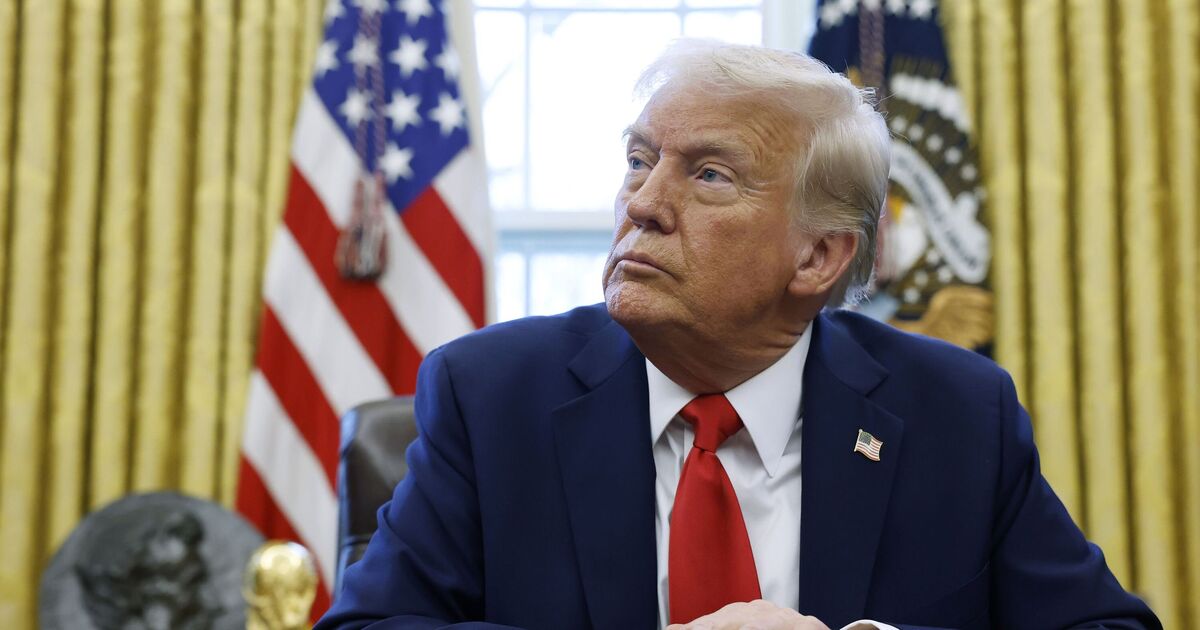
The alleged peace deal follows a 100-day timeline (Image: Getty)
Donald Trump is preparing to unveil his much-anticipated peace plan aimed at ending the ongoing conflict between Russia and Ukraine.
The proposal, which is expected to be disclosed at the Munich Security Conference next week, has already stirred significant debate, particularly regarding its potential implications for Ukraine and its allies in Europe.
A leaked draft of the plan, obtained by Ukrainian news outlet Strana, outlines a series of key provisions that could be controversial for both Ukrainian President Volodymyr Zelensky and European leaders. Critics like Mr Zelensky say the plan is merely Russian disinformation.
While Mr Trump has not officially confirmed the details, the potential terms are said to include a temporary ceasefire to freeze Russia’s advancing front lines. This pause would come into effect at Easter and would be followed by the establishment of a demilitarised zone, which could involve European troops, including from the UK, to oversee compliance.
Most interestingly, American forces would not be involved in this peacekeeping role, a point Mr Trump emphasised to distinguish his approach from previous US military interventions.

Donald Trump previously said he could end the war in Ukraine in one day… that timeframe has passed (Image: Getty)
Don’t miss… Insane moment Russian armour blasted as Putin ‘loses 1,200 men in a single day’
The proposed plan also suggests that Ukraine should remain neutral in the ongoing conflict and abandon its bid for NATO membership. However, Ukraine could still pursue integration with the European Union, with a target date of 2030 for potential membership.
The EU would also play a crucial role in Ukraine’s postwar reconstruction, according to Mr Trump’s supposed proposal, as part of a broader effort to ensure the country’s long-term stability and growth.
Perhaps the most contentious aspect of the plan involves the territory currently under Russian control.
Mr Trump’s plan appears to require Ukraine to accept Russian ownership of the regions that Moscow has occupied, which account for around 20% of Ukrainian land. These areas, which include Donetsk, Luhansk, Crimea, and Zaporizhzhia, have been subject to sham referendums conducted by Russia, further complicating any potential peace agreement.
The US President’s peace framework would also see sanctions on Russia gradually eased, with the revenue generated through special duties going towards rebuilding Ukraine’s war-torn infrastructure.
Mr Zelensky has been vocal in his opposition to any peace deal that compromises the country’s territorial integrity.
In response to the leaked plan, his office labeled it as “Russian disinformation,” dismissing it as an effort to weaken Ukraine’s position.
The Ukrainian President has long insisted that all of the occupied territory, particularly in the eastern regions, must be returned to Ukrainian control as part of any lasting peace agreement.
Despite this stance, he has acknowledged that regaining control of these areas might take time, given the complexity of the situation on the ground.
His primary objective remains securing Ukraine’s future within NATO – or at the very least, ensuring that the country is under the protective umbrella of the alliance.
He has repeatedly emphasised the importance of NATO membership as a safeguard against future Russian aggression, making it clear that NATO must cover all of Ukraine’s current territory to prevent further invasion attempts by Russia.

Volodymyr Zelensky described the leaked peace deal as ‘Russian disinformation’ (Image: Getty)
As he has voiced, Mr Trump believes the war could be ended swiftly through negotiations, with his appointed envoy, General Keith Kellogg, tasked with achieving a resolution within 100 days of the plan’s initiation.
However, the US President’s approach has raised concerns among some in Ukraine’s government, who fear that he could bypass Mr Zelensky altogether and strike a deal directly with Russian President Vladimir Putin. The potential for the US to cut military support for Ukraine to force its acceptance of a peace deal has added to these fears.
Mr Trump, who has repeatedly described Putin’s invasion as “ridiculous”, has made it clear that he would not hesitate to impose further economic sanctions on Russia if negotiations collapse. Reports suggest the financial pressure would be intensified in an effort to coerce Moscow into coming to the table.
Russia’s official objectives in the conflict have shifted over time, with early statements focusing on regime change in Ukraine, the demilitarisation of the country, and preventing NATO’s expansion into Eastern Europe.

